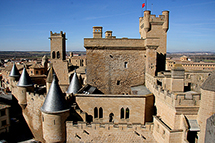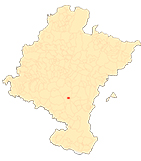The palace of Olite
By Javier Martínez de Aguirre
|
THE PALACE OF OLITE IN THE PANORAMA OF GOTHIC PALACES IN NAVARRE |
Overview
The Palace of Olite is a complex building in its history and its materiality. There is no way to take it all in at a glance, nor to understand it in a single visit. Whoever looks at it from place de los Teobaldos will think they are looking at a small urban fortress, given that almost everything on the other side of the parish of Santa María escapes them. Whoever sees it from the vicinity of the convent of San Francisco, will admire the apparently chaotic distribution of towers that both advance towards the viewer and retract, rising to unequal heights in a picturesque profile . Whoever enters through Portal del Fenero will be overwhelmed by the sheer size of the perimeter walls and will be unable to gain an intelligible perspective of the whole. The palace complex was built in successive phases, without responding to a complete architectural program previously designed, but rather obeying the economic possibilities, the whims of the monarch, the topographical conditions and the way in which builders and craftsmen of very different origins gave shape to what he requested of them. Thus, the turreted masses follow one another from the core of the Santa María quarter (the so-called "inner fence") towards the San Pedro quarter, taking as their axis the wall that enclosed the town on its eastern flank. Towers and courtyards were adapted to the unevenness of the terrain and the circumstances of the previous urban fabric without any desire for symmetry. The chaotic impression increases for the visitor who enters the interior and wanders through its twists and turns at different levels. Here and there doors open, staircases are arranged, rooms of all shapes and sizes follow one another, some clearly intended for residential use (with fireplaces and windows with bay windows), others whose purpose is difficult to clarify the abundant documents that its long Building and continuous interventions have generated since the fourteenth century to the present day.












